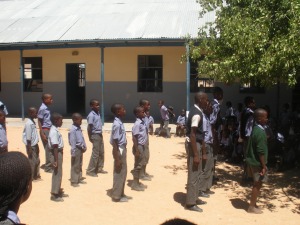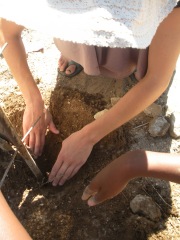Tomorrow is Namibian Independence day, 21 March. The country is celebrating 23 years of independence. It is incredible to experience the celebration with people who lived through the struggle for and attainment of independence. At Monday’s staff meeting my colleague Mr. Geingob was absolutely glowing. Upon greeting him he told me how excited he was that day 23 years ago and every day for this entire week. He told me that he’s been telling the learners how everyone knew independence was coming on 21 March. Being in grade 11 he was old enough to comprehend and appreciate the significance of what was about to happen. His excitement and appreciation has not faded in 23 years. I told him how special I thought it was that he remembered independence so clearly since for people in my country Independence was so far in the past that the significance can often be forgotten as people focus on barbecues and fireworks.
Here are photos and I’ll try to post videos separately from the short celebration we had at school today:

The “cadets” performed some traditional Herero drilling. This was really fun to watch. The boys get very into it and I like the way their shoulders and feet move like they are dancing.

Grade 3 learners spoke about children’s rights and sang a tribute to the late Minister of Education for giving children the right to free education.
Here are a couple pieces written by learners today. I suggested they write about independence for a social media site started by a group of Russian students who visited the school last year. It is part of a larger technology project, which aims to increase access to technology and link several schools in various countries around the world. It was part of their city’s bid to host an International event, but I forget which one at the moment. Here is a link to a video they created from their visits to all the school sites http://www.youtube.com/watch?v=2IgO6-skqCE and to more information about the project http://adorecreative.com/press/AdorePressReleaseGMA.pdf.
Independence in Namibia
Independence happens on 21 March 1990. Today is 20 March 2013. I want to tell you about what I do in Independence. We celebrate with my friends and we do drills. Many people died because of our right there were people who fought for freedom there name is Dr SAM NAUJOMA and Hendriek witbooi and other chiefs. Namibia was a colony by Germany in 1884 and then a colony of South Africa. There were white bread for white people and black bread for black people. There were white schools and black schools.
WRITEN BY GODLIEB KAETOUHANDU COSMOS
INDEPENDENCE
We celebrate independence on the 21of March. Namibia got independent in 1990 and many Namibians died because of this. First Namibia was a colony of Germany, and Hedriek wit booi was one of the people who fought for freedom. Samuel Maharero was the leader of the Ovaherero.
The first president of Namibia is DR Sam Nujoma
Written by Mbitukorua
















